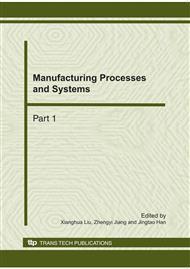p.934
p.938
p.943
p.949
p.953
p.957
p.963
p.967
p.974
Study on Strip Winding Machine for Prestressed Cold Forging Die
Abstract:
The strip wound die for cold forging operation is prestressed by the thin high-strength steel strips, which is characterized by the strength that is twice or more than that of the conventional compound die, as well as the achievement of even higher stiffness. In this paper, a special strip winding machine is designed and developed to manufacture the prestressed strip wound die. The structure and function of this machine is described in detail. FEM study on the frame of the machine is carried out to prove the feasibility of the design. The total tension will be determined by the constant tension which is equal to the friction force generated by the clamping device, and the variable tension which is generated by the AC servo motor in the uncoiler device. Controlling strategy and the framework of tension controlling system are also presented.
Info:
Periodical:
Pages:
953-956
Citation:
Online since:
October 2010
Authors:
Keywords:
Price:
Сopyright:
© 2011 Trans Tech Publications Ltd. All Rights Reserved
Share:
Citation:


